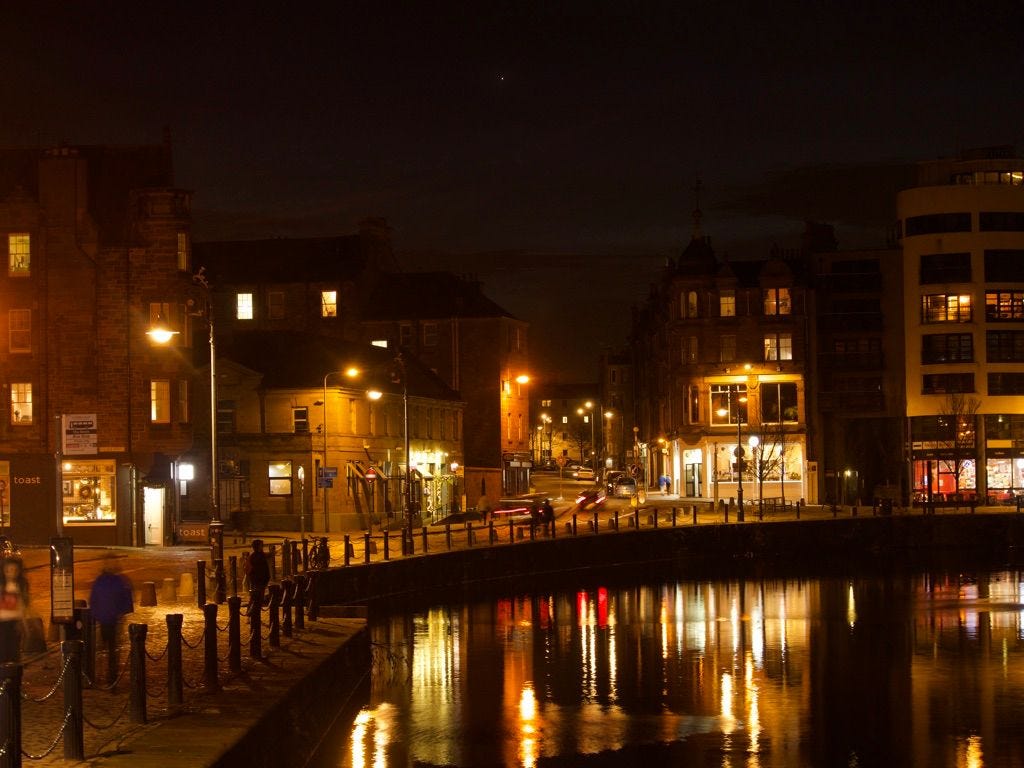The debate about water quality in the general election in Scotland seems shallow. The Scottish Lib Dems in particular seem to be making some overblown claims based on a misleading representation of the situation.
In Scotland, 87% of water is rated ‘good’ or excellent. (Only 14% of England’s water bodies reach that standard). That doesn’t mean there are no issues - 13% of Scotland’s water is therefore not good or excellent.
Scotland’s Water is - largely - in public ownership (read how that happened here). Scottish Water doesn't have to pay dividends to shareholders and it invests a bit more per household. But Scotland is a landmass not much smaller than England’s with a population a tenth of the size. So that wee bit more per head has to go a very long way - and there are a lot of challenges which don’t have obvious solutions. You can see some of these in Edinburgh’s river, the Water of Leith.
Case Study - the Water of Leith
One sunny spring morning last week, I leant on a rail watching the ducks, while a dad and his small daughter tried to feed them, not with bread which they like but we now know is bad for them, but with sweetcorn and peas. The brood disdained the offering, “It’s probably because it’s sort of half-defrosted,” the young man concluded.
Soon some less fussy pigeons swooped to claim the morsels, while the ducks tipped up and down in the muddy water, finding their own breakfast among the dozen kinds of fish that are apparently thriving there. Birds sang in the trees and a newly hatched mayfly fluttered past. I stopped to chat to volunteers from the Water of Leith Conservation Group who were doing a biological survey - they said the river is probably less polluted than it has been for hundreds of years.
However, my uncle David, who is in his 80s, remembers the water looking different, Today it is bubbly and dark brown, and there is a faint whiff of methane at points. David recalls climbing over the garden wall from their childhood home in Warriston Crescent to spend hours paddling in the clear water running over a pebbly bed. He, his siblings and assorted others would catch loaches and sticklebacks, and guddle, sometimes successfully, for trout.
Why does the water look so dense and dark now? It is probably not because of the levels of sewage, although traces of that do get in to the water. That is nothing new. The Water of Leith was once used as Edinburgh’s sewer. The Victorians then built a pipeline which mostly follows the line of the river and sometimes runs under it. There are places where you can see manhole covers next to or even under the water, which lead into the sewer.
When it rains, water from the whole basin drains rapidly into the river and the level can rise fast. Not all the water that gets into the river when it is raining heavily is clean. In a conventional sewerage system, storm drains and wastewater run into the same pipes. At times of heavy rain, when the pipes get full up and can’t cope with the volume of water, they vent - release excess water - into the river.
The places where this happens are called combined sewer outlets. There are 67 of these along the Water of Leith. 14 have already been upgraded and another 25 upgrades are underway. The upgraded CSOs get new pipes and screens intended to catch things like wet wipes and all visible particles. But it is likely that, after times of heavy rain, the water will still be contaminated by a tiny amount of faeces. It is not possible, as I understand it, to keep the rainwater and the sewage completely separate. Redesigning and rebuilding Edinburgh’s existing sewage system would be very costly and disruptive - and even then it wouldn’t completely prevent that.
Islands in the stream
There is another issue. Further down the Water of Leith at the Shore, the tidal flow is blocked by gates at the harbour. At night, the limpid waters reflect the lights of the pubs like a mirror or a painting - but by day you can see that the basin is being gradually filled in by a sludgy mass of mud and things the river carries.
The water may be a happy hunting ground for our web-footed friends, but it is gradually turning into a swamp. Below the surface, sixty years of vegetation is rotting, producing methane which sometimes bubbles up.
In the 1960s, the estuary was blocked at the docks by gates. The river no longer flows freely to the sea. Before that, it was tidal and the level could rise and fall by three metres in places. At low tide, the Leith end would have been mud flats. The tide would have cleaned out the river bed twice a day
Down at the docks, Forth Ports can open the gates if the water levels rise - on these occasions, you might see the water drop by a metre. A friend says that water levels are well-managed between the different authorities. There are three reservoirs in the Pentlands that also have to let water into the river when they get overfull, and then the staff notify the Port. The Port staff also monitor the water levels at various flashpoints along its course.
Normally, it is straightforward to manage the situation, because the levels in the locks at the docks are much higher than in the Firth. But occasionally, on a high spring tide, for example, the water levels are close to equal. Then it is a question of timing, holding the water in the river until the tide falls. But letting the water out doesn’t take away the silt.
What is the solution to this problem? Even if you made it tidal again it would take years for the sea to clean up the mess we have created. And there are probably pollutants in the the mud too, from the days when distillers and tanners ran their effluent into the river. I often look at people sitting on the edge in summer and wonder if they realise how dangerous it would be to fall in.
Removing the gates - which isn’t going to happen - could create other issues. Would river walls that have been continually submerged for 60 years crumble if the water levels changed? What about rising sea levels because of climate change? Letting the sea back into the river could cause different flood risks.
Dredging the river would reduce the build-up of vegetation - but dredgers can’t get up under the bridges so another way of doing it would have to be found. The stench would be fearful, and the reclaimed matter would have to be taken somewhere.
Obviously, this operation to make the river healthy again would cost money. Scottish Water is responsible for managing what goes into the river. But it seems unfair that the public body's scarce resources should have to pay for the damage caused by the blockage at the port. The Port of Leith was once publicly owned - UK Ports were privatised by Margarete Thatcher’s government in 1982 - but now it is part of Forth Ports. The commercial entity doesn’t have any legal responsibility to dredge the river, but perhaps pressure could be brought to bear on them to assist with the operation.
Is there a risk that the process of silting up the basin will eventually form a solid bank that flood water could rush over onto the land? Does anyone really know the answer? Did the city fathers who built the locks at the port foresee the problems that would result? Issues like these are not uncommon to urban waterways - because people aren’t always very good at understanding how their behaviour will affect rivers.
An amusing illustration of this point comes from another of my uncle’s memories of the Water of Leith. A neighbour had a pet duck and invited the local children to help knock a hole in the wall so it could get access to the river. My father Arnold was among them, and enthusiastically joined in, using old bits of metal and iron bars. When the river rose in the great flood of 1947 (caused by snowmelt), water poured through the hole, broke down the wall and flooded several houses. My family were on holiday in Glen Clova and the first they heard was a telegram saying “Don’t worry, firemen pumping water out”.
Conclusion
Scotland’s water quality is rated as among the best in Europe. It does indeed occasionally have cases where nasty bugs like cryptospiridium are found in drinking water supplies - take a look here. But at least one of the 2023 cases involved deer poo getting into the treatment works at Achiltibuie. I am not sure what measure Socottish Water could take to prevent that - the important thing is to deal with it promptly when it happens.
The Lib Dem demand that Scotland monitors bathing quality right across the country seems a bit bananas. Is it really a good use of scarce resources to continually monitor bathing quality at Arisaig or Sandwood Bay?
And whatever the Scottish Liberal Democrats say, unfortunately it is not possible to make an urban river like the Water of Leith completely free of traces of faeces at all times. The flood drainage system that we have now has been in place since the late 19th century. What the Lib dems call ‘raw sewage’ is largely grey storm water and unless we want to find a ton of billions to change that, we will have to live with it, as the ducks do.
But the Liberal Democrats are not completely wrong. Climate change increases the risk of lots of rainfall falling in a short time and the flood risk is already high as you can see from the map above. There are serious challenges facing Edinburgh - and other areas - in terms of managing this. And, as often with nature, each intervention risks unintended consequences that may require another.
Read about the evolution of Edinburgh’s sewer network here







What a wonderfully balanced and researched wee article! As a water professional, the detail with which the mechanics and historical legacy of our inherited infrastructure severely constrain radical redesign is mostly lost in outrage. Which makes your piece all the more refreshing to read.
The tidal lock aspect was actually unknown to me but immediately highlighted a fundamental weak point in the context of increasingly random flash flooding.
Excellent article